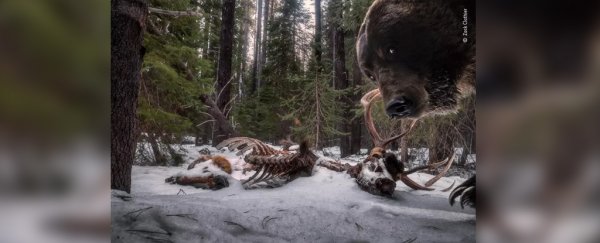A grizzly bear attacked a photographer's camera and ended up starring in a grisly photo that has won the photographer an award.
Zack Clothier, a professional photographer based in Montana, set up a camera trap pointing at an elk carcass hoping to get some shots of scavenging wildlife. He returned to find his camera setup trashed and one clear picture of the culprit: a large grizzly bear (Ursus arctos horribilis).
The photo, called 'Grizzly leftovers', captures the bear just before it lunges at the camera. Clothier found out his picture won the 2021 Wildlife Photographer of the Year prize for the Animals in their Environment category at an awards ceremony on Oct. 12.
 (Zack Clothier/Wildlife Photographer of the Year)
(Zack Clothier/Wildlife Photographer of the Year)
Above: 'Grizzly leftovers' won its 2021 Wildlife Photographer of the Year competition category.
"I was in shock, I actually could not believe it," Clothier told Live Science. "I really like the image, it's definitely a unique image."
Clothier discovered the elk carcass near his home in Montana during the winter of 2019-2020. He set up a camera trap by sealing his camera in a case and placing it on a tripod by the carcass for about two months, until the beginning of spring, when bears start emerging from their winter dens.
On his way back to the area where he left his camera, Clothier found bear tracks on the trail leading to the carcass. He checked another camera he'd set up to monitor the trail and saw footage of a large male grizzly bear making the tracks earlier that morning.
"I hung around there for a little while just kind of making noise, just to spook anything off the carcass that may have been on it, especially that bear," Clothier said. When he didn't hear anything, he cautiously approached the carcass.
Clothier found his camera case in rough shape at the base of a tree near the carcass. The camera had been ripped off its tripod and was pointing up in the air, with claw marks on the case and slobber all over the lens.
Fortunately, the camera survived the attack inside its case and Clothier retrieved the photos of the bear. Camera traps have an infrared sensor and take pictures when the sensor detects movement. Bears can be very protective of carcasses and the sound of the camera shutter may have startled the bear.
"I think he just heard the sound and didn't like it, and decided to trash it," Clothier said.
"I've had black bears do similar things. A lot of times it's more curiosity with them I think. They come up and inspect the camera and nose the lens and bite the case, and kind of bash it around a little bit. Bears definitely have something against camera traps."
'Grizzly leftovers' went on display with other photos from the 2021 Wildlife Photographer of the Year competition in London on Oct. 15. The exhibition will tour internationally, including to the US.
Wildlife Photographer of the Year is developed and produced by the Natural History Museum, London. The museum is accepting entries for next year's competition starting Monday (Oct. 18) until 6:30 am ET on December 9.
Related content:
The 100 best science photos of 2020
'Explosive' photo captures 'otherworldly beauty' of spawning fish during a full moon
These are the best astronomy images of the year
This article was originally published by Live Science. Read the original article here.
